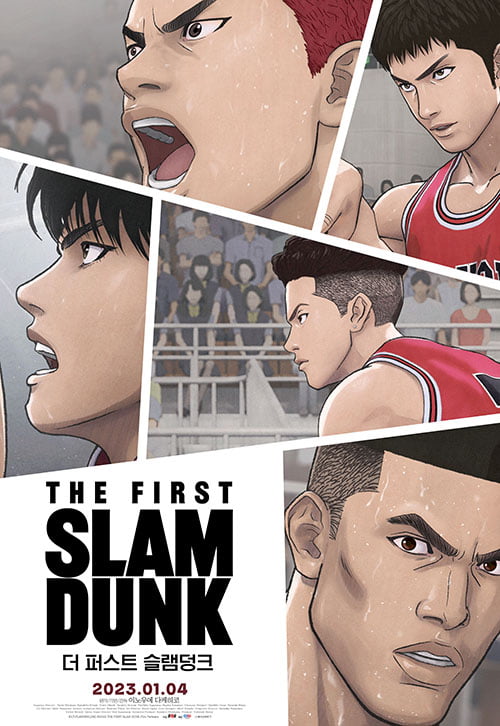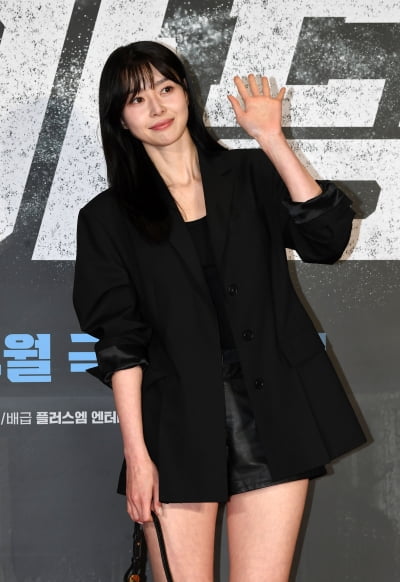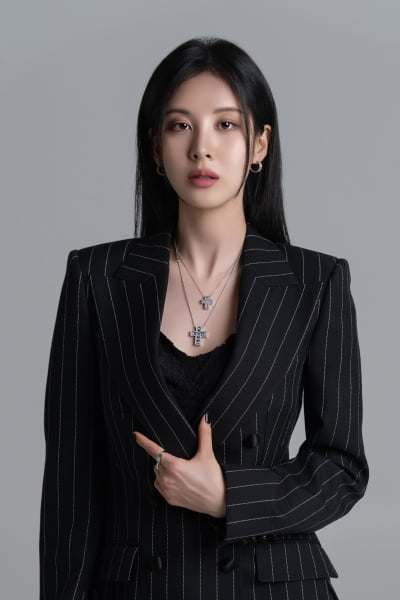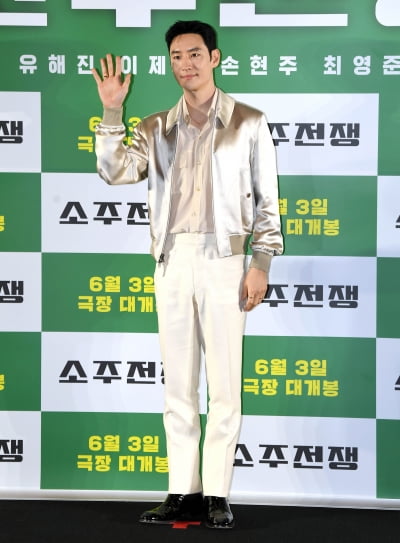MOVIE
Director of ‘Slam Dunk’: “Song Tae-seop is the main character, not Kang Baek-ho”
Interview with director Takehiko Inoue of ‘The First Slam Dunk’

A. We received a production offer more than 10 years ago. I made a pilot video, but I rejected it because I thought it wasn't what I wanted. However, even though the process of making a short video was very difficult, I felt the enthusiasm of the production team who continued to make suggestions.
Q. When did you finally say OK?
A. It is 2014. The deciding factor was the ‘face’ of the pilot video. The soul of the person who created it seemed to be making a strong appeal. Rather than the technology or video quality, the emotional aspects such as enthusiasm and spirit touched me the most. I don't know much about animation-related technology, but I think technology is only a means. For example, CG for basketball scenes was chosen because it was the most suitable method for depicting 10 people moving on the court.
Q. When you gave the OK to production, did you intend to take charge of the script yourself?
A. It wasn't. However, at the time I answered ‘OK’, I was thinking that it was related in some way. Because I thought that was the only way I could understand it. For example, after watching the pilot film, I thought, ‘This is how I want to do it.’ So, my biggest thought was that if 'Slam Dunk' was to be made into a movie, wouldn't it be better for me to be involved at least a little? That would help the work and make readers happy.
Q. Isn’t the weight of ‘being involved’ and ‘supervising’ different?
A: Yes. This result was reached for various reasons, but it may have been thanks to my experience as a cartoonist so far that I, a beginner in film production, was able to say, 'I will direct.' When conducting the 'Last Manga Exhibition' (Takehiko Inoue's exhibition that toured Japan in 2009-2010), like this time, I entered the field as a beginner when it came to exhibitions. I think my experience of being involved as an important person several times, even though I was an amateur, was helpful.

A. I had the image in my mind of ‘I want to do it this way,’ but I didn’t have the experience or knowledge. When a rough image was presented, experienced staff members interpreted or conveyed it by saying, ‘Isn’t this what it feels like?’ Rather than rushing towards a single point that clearly said, ‘This is the goal,’ from the beginning, we built it up together and ultimately completed it with the feeling of, ‘We’ve reached it!’
Q. Realistic basketball expressions are also a big feature. What are particularly important points in drawing game scenes?
A. It's a very detailed part, but it expresses the 'basketball-ness' that I remember with my body, such as the way I step on my foot, my body's reaction the moment I catch the ball, and the timing when I go for a shot. I was concerned about how far such nuances could be conveyed since none of the staff members had played basketball, but I thought it was great that the production team actually went to learn how to play basketball and tried playing it themselves. I hope you still like basketball. I hope you don’t get tired of this work and think, ‘I don’t even want to look at basketball anymore.’
Q. All the self-talking and comical scenes between matches that appeared in the original work have disappeared.
A. This is something I felt while progressing, but there were not many detailed gags from the original work. In comics, simple comic scenes can be added as interludes, but in movies, the screen size is constant, so even if gags are placed in every corner, they are not visible. The biggest difference between comics and movies was that they took place on a large screen. If it were a cartoon, the answer could have been found by dividing cells, etc., but I couldn't find the method in a movie, and rather than being too obsessed with it, I decided that cartoons would have their own enjoyment and movies would have their own fun, so I decided to prioritize 'basketball-ness'. got off
Q. I think many fans were surprised that the main character was Song Tae-seop and not Kang Baek-ho.
A. I didn't want to make the original work exactly the same, so if I were to do 'Slam Dunk' again, I wanted to do it from a new perspective. Even when Song Tae-seop was serialized in comics, he was also a character that I wanted to draw more narratives about. In the third year, centers Chae Chi-soo and Dae-man Jeong, Baek-ho Kang and Taewoong Seo were first-year rivals, so second-year student Song Tae-seop was caught between them. So this time I decided to draw Song Tae-seop.
In the original work, the character's family story is not well depicted, but in this work, Song Tae-seop's family story is depicted quite deeply. When I wrote the series, I was in my 20s, so I was better able to draw from the perspective of a high school student, and that was all I knew. Now that I'm older, my horizons have broadened and the scope of what I want to draw has broadened. After drawing ‘Slam Dunk’, drawing ‘Vagabond’ and ‘Real’ also had an influence, so I think it was natural. The values drawn in the original work are very simple, but since I am involved now, what I learned after drawing the original work is that I had no choice but to add the perspective that 'there is not just one set of values, and even if there are several, it is okay as long as each person has their own answer.' .PART 3. I wanted to place the most importance on the feeling that the characters were ordinary high school students.Q. What was the most important factor in casting voice actors for this work?
A. It is the quality (texture of the voice). When I drew a cartoon, I couldn't hear the voice clearly inside me, but there was a vague sense of texture, such as the gloss of the voice, the pitch, and whether it was a little hoarse or thick and serious. I chose the right person for that.
Q. What kind of direction did you give when recording?
A. Rather than feeling like I was playing characters from an animation, I wanted to value the feeling that they were ordinary high school students. After explaining the character to the voice actors, saying, ‘This is what this character is like,’ I gave them direction by saying, ‘Please keep your tone as similar to your usual tone as possible.’ When I draw a cartoon while recording, I cannot hear the character's voice, but as I put text into the speech bubble, I realize that I have unconsciously captured the loudness and quietness of the voice and the feeling while speaking through the size of the text, shape of the speech bubble, and location. It was. That was the biggest help when giving specific directions.
Q. How do you feel after finishing recording?
A. I was impressed. It was my first time working with a voice actor on set, and it was cool to come with just one body and compete with just my voice, like a swordsman fighting with just a sword. Everyone was wondering, ‘How should I play this guy?’ I felt really grateful as I heard that the recording was getting better as time went by.
Q. What made you choose The Birthday and 10-FEET as the theme song?
A. For the opening, I wanted a long intro with a slightly disturbing atmosphere, starting with one note and gradually increasing into various sounds. Since I was a fan of The Birthday, I really wanted to ask them. 10-FEET put a lot of effort into the ending and the music in the play. They gave me a lot of good demo songs and when I asked, ‘Can I do this more?’, they gave me different suggestions, and from there, they corrected me in detail over and over again, so I can’t even bow my head in gratitude.
Q. Did you make any specific requests regarding the song?
A. Basically, the same as the story I mentioned earlier, I only presented the image of ‘I want this feeling’ and adjusted the rest. Every time I listened to the song, I was amazed at how amazing the power of the sound was.
Q. The staff said they were surprised by the accuracy of the director’s judgment. Even if the sound source was only slightly different, he made an unwavering judgment that ‘this side is OK and this side is no.’
A. Maybe it's because I don't have any expertise. In a good way, it could be 'I was able to make a flat judgment because I had no preconceptions', or in a bad way, it could be 'It was my first time and I didn't know what the right answer was, so I had no choice but to use all my senses and think from the beginning.' Should we say that even people who could rest were unable to rest due to lack of experience or know-how? It must have been very difficult for everyone, but I am really grateful to the staff who patiently helped me and worked with me to find the best path.

A. It's a cartoon. From a third party's perspective, it may seem like I'm doing many things other than comics, but within me, there's only one path. I face it all as a cartoonist, and all my experiences come back to me as a cartoonist. Art museum exhibitions, illustration work, and this film are all done with the thought, “I can do these things with comics.” I believe that gaining various experiences and improving yourself ultimately leads to drawing good comics.
Q. Lastly, what is your message to ‘Slam Dunk’ fans?
A. We created ‘Slam Dunk’ from a new perspective and perspective. A cartoon becomes a cartoon, an animation becomes an animation, a movie becomes a movie, it is a work created with a new life. In the end, they all have the same roots, and even if you already know 'Slam Dunk', I hope you can feel 'there's a slam dunk like this too.'
Choi Ji-ye, Ten Asia Reporter wisdomart@tenasia.co.kr



